View in other NatureServe Network Field Guides
NatureServe
Montana
Utah
Wyoming
Idaho
Wisconsin
British Columbia
South Carolina
Yukon
California
New York
Niobrara Ambersnail - Oxyloma haydeni
Other Names:
Oxyloma retusum, Oxyloma retusa, Succinea haydeni
General Description
Shell is oblong-ovate (succineiform), to about 21 mm in length and 9 mm in width, thin, with irregular wrinkles and spiral furrows, about 3 whorls with a short spire. Shell coloration glossy amber. Aperture is oblique, ovate, and somewhat narrow, 2/3 to 3/4 the shell length (Hendricks 2012, Burke 2013).
Diagnostic Characteristics
The Succineidae is a most difficult family, with no sure way of distinguishing genera, let alone species, from shell characteristics. In general, Catinella have shorter shells with a rounder aperture and relatively higher spire. Succinea are larger-shelled with more ovate apertures and swelling around the genital opening behind the right tenticle. Oxyloma are similar in size to Succinea but are narrower (larger ratio of height to width), with longer, narrower, ovate apertures (Burke 2013). Specific determination requires the aid of an expert.
Species Range
Montana Range
Range Descriptions
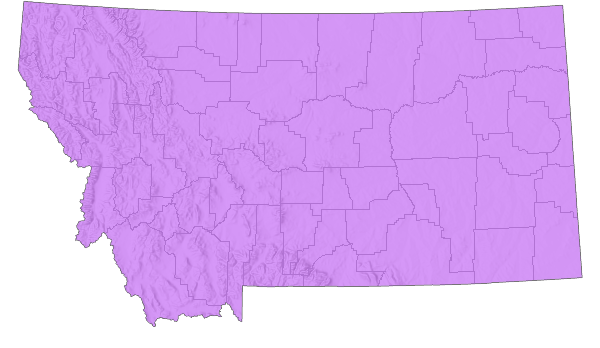
 Native
Native
Range Comments
Native to North America; prairies and prairie parklands from Alberta to Manitoba south to Nebraska. In Montana, reported on both sides of the Continental Divide from seven counties: Broadwater, Flathead, Gallatin, Glacier, Lake, Pondera, Wheatland. Elevation range is 814 to 1902 m (2670 to 6240 ft). Montana reports of O. retusa east of the Continental Divide are possibly O. haydeni. Reports of O. haydeni west of the Continental Divide possibly should be assigned to O. missoula or some other Oxyloma species. O. retusum (= retusa) is now considered a species of eastern North America, whereas O. haydeni is the most common species of the prairie parklands east of the Rocky Mountains. Range and abundance poorly understood in Montana; current status needs investigation (Hendricks 2012).
Observations in Montana Natural Heritage Program Database
Number of Observations: 13
(Click on the following maps and charts to see full sized version)
Map Help and Descriptions
Relative Density
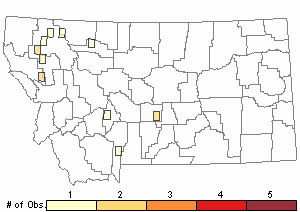
Recency
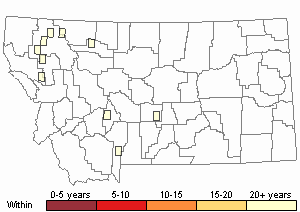
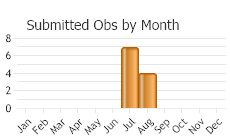
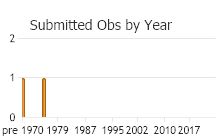
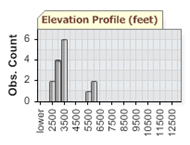 (Observations spanning multiple months or years are excluded from time charts)
(Observations spanning multiple months or years are excluded from time charts)
Habitat
Prairie riparian areas, near rivers, streams, and springs. Canopy species include cottonwoods. Found under woody debris and leaf litter in moist places. Habitat in Montana poorly documented (Hendricks 2012).
Stewardship Responsibility
References
- Literature Cited AboveLegend:
 View Online Publication
View Online Publication Burke, T. E. 2013. Land snails and slugs of the Pacific Northwest. Corvallis, OR: Oregon State University Press. 344 p.
Burke, T. E. 2013. Land snails and slugs of the Pacific Northwest. Corvallis, OR: Oregon State University Press. 344 p. Hendricks, P. 2012. A Guide to the Land Snails and Slugs of Montana. A report to the U.S. Forest Service - Region 1. Montana Natural Heritage Program, Helena, MT. vii + 187 pp. plus appendices.
Hendricks, P. 2012. A Guide to the Land Snails and Slugs of Montana. A report to the U.S. Forest Service - Region 1. Montana Natural Heritage Program, Helena, MT. vii + 187 pp. plus appendices.
- Additional ReferencesLegend:
 View Online Publication
View Online Publication
Do you know of a citation we're missing? Beetle, D.E. 1989. Checklist of recent Mollusca of Wyoming, U.S.A. The Great Basin Naturalist 49(4):637-645.
Beetle, D.E. 1989. Checklist of recent Mollusca of Wyoming, U.S.A. The Great Basin Naturalist 49(4):637-645. Beetle, D.E. 1997. Recolonization of burned aspen groves by land snails. Yellowstone Science 5 (summer):6-8.
Beetle, D.E. 1997. Recolonization of burned aspen groves by land snails. Yellowstone Science 5 (summer):6-8. Berry, S.S. 1913. A list of Mollusca from the Mussellshell Valley, Montana. Nautilus 26:130-131.
Berry, S.S. 1913. A list of Mollusca from the Mussellshell Valley, Montana. Nautilus 26:130-131. Berry, S.S. 1916. Notes of Mollusca of central Montana. Nautilus 29:124-128.
Berry, S.S. 1916. Notes of Mollusca of central Montana. Nautilus 29:124-128. Harris, S.A. and L. Hubricht. 1982. Distribution of the species of the genus Oxyloma (Mollusca, Succineidae) in southern Canada and adjacent portions of the United States. Canadian Journal of Zoology 60:1607-1611.
Harris, S.A. and L. Hubricht. 1982. Distribution of the species of the genus Oxyloma (Mollusca, Succineidae) in southern Canada and adjacent portions of the United States. Canadian Journal of Zoology 60:1607-1611. Pilsbry, H.A. 1948. Land Mollusca of North America (north of Mexico), Volume II Part 2. The Academy of Natural Sciences of Philadelphia Monograph Number 2(2): 521-1113.
Pilsbry, H.A. 1948. Land Mollusca of North America (north of Mexico), Volume II Part 2. The Academy of Natural Sciences of Philadelphia Monograph Number 2(2): 521-1113.
- Web Search Engines for Articles on "Niobrara Ambersnail"
- Additional Sources of Information Related to "Snails / Slugs"





